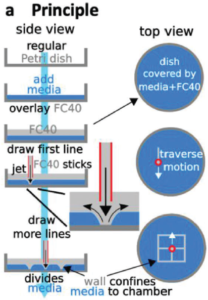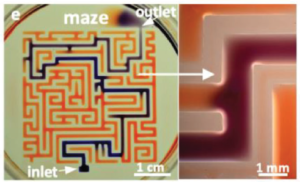 New research from Edmond Walsh’s group at the University of Oxford and Iota Sciences demonstrates rapid in situ device prototyping in a plastic Petri dish using robotic jet printing. The work was published in Advanced Science 2 weeks ago.
New research from Edmond Walsh’s group at the University of Oxford and Iota Sciences demonstrates rapid in situ device prototyping in a plastic Petri dish using robotic jet printing. The work was published in Advanced Science 2 weeks ago.
Beginning with a Petri dish containing an aqueous cell medium, the procedure entails covering the medium with a second immiscible layer of FC40 fluorocarbon, and then jetting the fluorocarbon through the medium to make contact with and stick to the Petri dish via preferential wetting. The moving jet nozzle can thus define channel & chamber walls bonded to the Petri dish surface and directly write a fluidic channel network according to a CAD layout input. The jet stays in the fluorocarbon, making the fabrication contactless. Writing time depends on the design complexity, but may be about five minutes. A diagram of the fabrication procedure is shown at right above, and a fluidic maze structure created with this technique is show at right below. First author Cristian Soitu’s Twitter feed (@CristianSoitu) has an impressive video showing the creation of some devices.
 The authors have done a nice job of characterising the various parameters relevant to creating walls or features from the fluorocarbon, such as jet nozzle height, diameter, flow rate, lateral speed, wall thickness and channel widths. The ability to pipet into enclosed chamber arrays was also explored in terms of volume ranges and resistance to cross-contamination. Preliminary cloning studies with different cells suggested comparable cloning efficiency vs. normal Petri dishes without fluorocarbon structures.
The authors have done a nice job of characterising the various parameters relevant to creating walls or features from the fluorocarbon, such as jet nozzle height, diameter, flow rate, lateral speed, wall thickness and channel widths. The ability to pipet into enclosed chamber arrays was also explored in terms of volume ranges and resistance to cross-contamination. Preliminary cloning studies with different cells suggested comparable cloning efficiency vs. normal Petri dishes without fluorocarbon structures.
The possibilities afforded by such a direct-write technique are compelling. An ability to create custom microfluidic structures for a given pattern of cells or conceivably other analytes adsorbed on a solid substrate with secluded, sterile and controllable environments seems like a window into new analytical techniques enabled by powerful sampling and work-up strategies. Iota Sciences appears to be moving the technology forward for cell cloning purposes.
